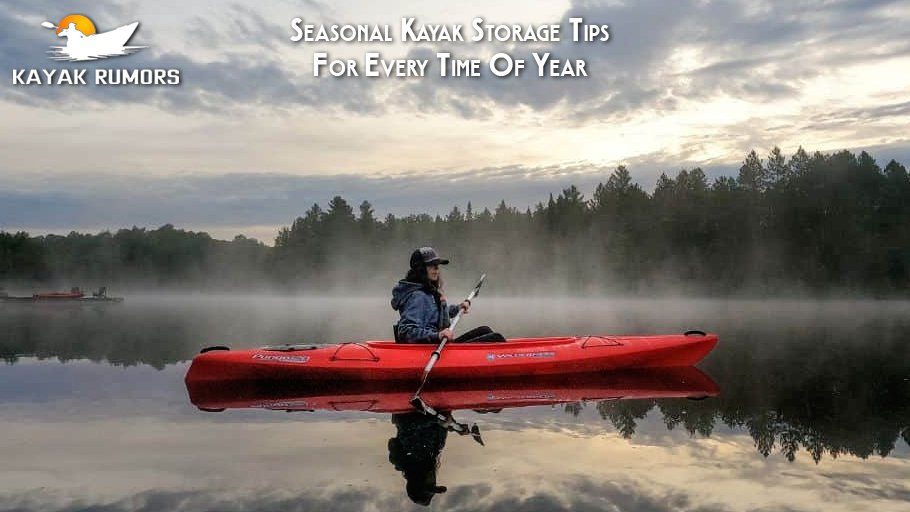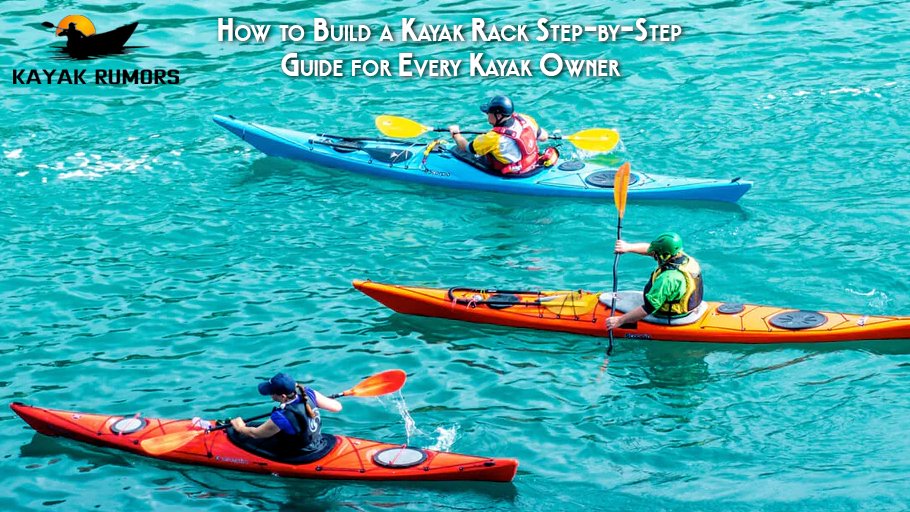How to Store a Kayak: Start with the Right Storage Mindset
Before examining racks or covers, it’s essential to understand why proper kayak storage is important. Kayaks aren’t just bulky — they’re made from materials that can bend, crack, or fade when not stored the right way. Learning how to store a kayak helps you avoid long-term issues like warping, mold, or sun damage. It’s not just about convenience. It’s about protecting your gear and getting more years out of it.
Whether you use a kayak a few times a year or paddle every weekend, how you store it affects its performance in the water. A bent hull can throw off your balance. A kayak left out in the sun for months can weaken. These things don’t always happen right away, but over time, poor storage causes wear you can’t reverse.
When people ask how to store a kayak, they often assume there’s just one answer. But the truth is, it depends on a few things — like your space, the type of kayak, and how often you use it. This guide will walk you through practical storage options and give you smart tips based on real experience, not just theory.
Coming up next, let’s look at indoor vs. outdoor storage — and how to choose the best spot for your kayak.
Indoor vs. Outdoor Storage: What’s Better for Your Kayak?
When deciding how to store a kayak, the first thing to figure out is where it’s going — indoors or outdoors. Both options can work well, but each has pros and cons. The key is choosing the one that fits your space and keeps your kayak protected long-term.
Indoor Kayak Storage
Storing your kayak indoors is ideal because it shields it from sunlight, moisture, and extreme temperature changes. Garages, basements, sheds, and even large closets can work if you’ve got the space.
Benefits of storing a kayak indoors:
- Keeps the kayak safe from UV rays, which can fade or crack plastic
- Protects from rain, snow, and fluctuating humidity
- Reduces the risk of pests, theft, or vandalism
- Extends the life of the hull and other materials
If you choose to store indoors, make sure your kayak has enough room around it. Avoid placing heavy objects on top or storing it flat on a hard floor for long periods — that can cause dents or warping over time.
Outdoor Kayak Storage
If indoor space is tight, outdoor storage can still be a solid choice — as long as you take a few extra precautions. You’ll need to cover your kayak properly and keep it off the ground.
Best practices for outdoor storage:
- Use a weather-resistant cover to block out UV rays and rain
- Store the kayak on a rack or raised surface to avoid ground moisture
- Secure it against strong winds or potential movement
- Keep it in a shaded or sheltered spot if possible
Some people store kayaks under a deck, along a fence, or on a covered patio. These are all workable options as long as the kayak stays dry and out of direct sunlight for long stretches.
Best Kayak Storage Options: Racks, Wall Mounts, and More
Once you’ve picked the right spot — indoors or outdoors — the next step is choosing a storage method that keeps your kayak safe, supported, and in good shape. There are plenty of options out there, and the right one depends on your available space and how often you use your kayak.
Let’s break down the most popular storage solutions:
1. Wall Mounts
Wall mounts are a great way to store a kayak off the ground and out of the way, especially if you’re tight on floor space. You can install them in a garage, shed, or even on a covered outdoor wall.
Why wall mounts work:
- Saves space
- Keeps the kayak secure
- Easy to access when you need it
- Helps maintain the shape of your kayak
Just make sure the wall is strong enough to support the weight of your kayak, and always follow the instructions when mounting.
2. Free-Standing Racks
If you want flexibility, a free-standing rack is worth considering. It doesn’t require drilling or wall space — just place it on a flat surface and go.
Free-standing rack benefits:
- Easy to move or reposition
- Works well for multiple kayaks
- Ideal for garages, sheds, or backyards
- No wall mounting needed
Choose one with padded arms and sturdy materials to avoid scratches or pressure damage.
3. Ceiling Hoists
Have a high ceiling in your garage or storage room? A ceiling hoist can help you lift the kayak up and out of the way while using your space efficiently.
Good reasons to go with a hoist:
- Maximizes vertical space
- Keeps your kayak completely off the ground
- Great for long-term storage
- Adds an extra layer of protection
Hoists are especially helpful if your kayak is large or heavy. Just make sure the system you choose is designed for kayak weight and size.
4. Kayak Storage Covers
No matter how you store your kayak, a quality cover is essential — especially for outdoor storage. It protects your kayak from sun damage, dust, dirt, and moisture.
Key features to look for:
- UV protection
- Water resistance
- Breathable material to reduce mold or mildew
- Tight fit to prevent shifting or slipping
A storage cover is a small investment that helps extend the life of your kayak, especially during off-season months.
Common Kayak Storage Mistakes to Avoid
Even with the best intentions, many people end up damaging their kayaks just by storing them the wrong way. Knowing what not to do is just as important as knowing how to do it right. Let’s look at the most frequent storage mistakes and how to avoid them.
1. Storing on a Hard, Flat Surface
Lying your kayak directly on the floor — especially on a hard surface — can lead to warping. Kayaks aren’t designed to support their full weight in one spot. Over time, this pressure can change the shape of the hull.
Better alternative: Use padded supports or a proper kayak rack that distributes weight evenly across the body.
2. Keeping It in Direct Sunlight
Sun exposure can cause long-term damage to your kayak. The UV rays dry out the plastic, fade the color, and weaken the material, making it more likely to crack.
Pro tip: If you’re storing your kayak outside, always use a UV-resistant cover or keep it under a shaded area.
3. Storing It Upside Down or Right-Side Up on the Floor
Both positions can cause pressure points and deformation if done incorrectly. Placing it right-side up might collect water or debris inside, while storing it upside down without support can damage the cockpit rim.
What to do instead: Use wall mounts, slings, or racks designed to hold the kayak at a slight angle with weight evenly supported.
4. Not Securing the Kayak Properly
If your kayak is just leaning against a wall or loosely tied down, it could fall and get damaged — or even injure someone.
Quick fix: Use strong, adjustable straps or a storage rack that holds it firmly in place, especially if it’s suspended or mounted high.
5. Skipping Regular Checks
Even in storage, kayaks can develop issues like mold, mildew, or pest problems. Ignoring your kayak during off-season months can lead to unpleasant surprises when you’re ready to use it again.
Tip: Check your kayak every few weeks. Make sure it’s dry, clean, and free from damage.
Avoiding these mistakes can extend the life of your kayak and save you from unexpected repairs or replacements. In the next section, we’ll guide you through seasonal storage tips — so your kayak stays in great shape, whether it’s winter or summer.
Seasonal Kayak Storage: Tips for Every Time of Year

Storing your kayak properly depends a lot on the season. Different weather conditions affect your kayak in different ways. Whether it’s hot summer months or cold winter days, knowing how to adjust your storage routine can keep your kayak safe and ready to use all year long.
Summer Storage Tips
During summer, the biggest threat to your kayak is heat and sun exposure. Intense sunlight and high temperatures can dry out the materials, causing cracks or fading.
- Keep it shaded: Store your kayak under a canopy, garage, or covered area to protect it from direct sunlight.
- Use UV covers: If shade isn’t available, use UV-resistant covers designed for kayaks. They shield the surface and keep the color fresh.
- Avoid storing in hot garages: High heat inside garages can warp plastic hulls. If you must store it indoors, keep it well-ventilated.
Winter Storage Tips
Winter poses different challenges, especially if you live in areas with freezing temperatures, snow, or moisture.
- Dry it thoroughly: Before storing, clean and dry your kayak fully to prevent mold and mildew.
- Store indoors if possible: A cool, dry place like a basement or garage works best.
- Use padded racks: Keep your kayak off the floor to avoid moisture damage and warping.
- Cover it up: Use a breathable cover to protect from dust and potential pests.
Off-Season Storage Ideas
If you won’t be using your kayak for months, consider these extra steps:
- Loosen the straps: If your kayak is strapped down, don’t leave the straps too tight. This can create pressure points and deform the kayak.
- Remove accessories: Take off paddles, seats, and other removable parts. Store them separately to avoid damage.
- Check periodically: Visit your storage area every few weeks to air out your kayak and check for any issues like moisture buildup or pests.
Best Kayak Storage Options for Your Space
Finding the right place and method to store your kayak can make a big difference in its lifespan and your convenience. Whether you have a small apartment or a spacious garage, there’s a storage solution that fits your needs.
1. Wall-Mounted Racks
Wall racks are a popular option because they keep your kayak off the floor and out of the way. These racks usually come with padded arms or hooks to protect your kayak’s surface.
- Pros: Saves floor space, easy to access, protects the kayak from damage.
- Cons: Requires wall space and drilling.
Perfect for apartments or garages where space is limited but walls are available.
2. Ceiling Hoists
Ceiling hoists use pulleys to lift your kayak up and store it overhead. This keeps your kayak safe and frees up floor space for other gear.
- Pros: Great for small spaces, keeps kayak out of reach from pets or kids, adjustable height.
- Cons: Installation can be tricky, may need strong ceiling anchors.
Ideal for garages or basements with high ceilings.
3. Freestanding Racks
If you don’t want to drill into walls or ceilings, freestanding racks are a flexible solution. They can hold one or multiple kayaks and are movable.
- Pros: No installation required, portable, can hold several kayaks.
- Cons: Takes up floor space, can be bulky.
A good choice if you rent your home or want a temporary storage option.
4. Outdoor Storage Covers and Sheds
When indoor storage isn’t an option, outdoor solutions can protect your kayak from weather elements.
- Kayak covers: Waterproof and UV-resistant covers help shield your kayak from rain, sun, and dirt.
- Storage sheds: Small outdoor sheds or dedicated kayak lockers keep your gear safe and organized.
- Pros: Protects from harsh weather and keeps the kayak secure.
- Cons: Outdoor exposure still risks some damage, requires space.
Great for those with yards or patios who want to keep their kayak nearby.
How to Prepare Your Kayak for Long-Term Storage
Storing your kayak properly isn’t just about finding space — it’s also about getting your kayak ready to stay safe and sound over time. Whether you’re putting it away for a few weeks or months, a few simple steps can protect your kayak from damage, mold, and wear.
Clean It Thoroughly
Before storing your kayak, make sure it’s clean and dry. Dirt, salt, and water can cause damage or attract mold if left on the surface.
- Rinse off dirt, sand, or saltwater with fresh water.
- Use a mild soap if needed, but avoid harsh chemicals.
- Dry the kayak completely to prevent mold growth.
Check for Damage
Take a close look at your kayak for any cracks, holes, or wear. Fixing small issues before storage prevents them from getting worse.
- Patch any cracks or holes using a kayak repair kit.
- Inspect and tighten any loose screws or fittings.
- Remove any detachable parts like seats or pedals and store them separately.
Protect from Sun and Moisture
Sunlight and moisture can cause fading, warping, or material breakdown during storage.
- Store your kayak in a shaded or covered area.
- Use a breathable cover to keep dust and moisture away but allow airflow.
- Avoid plastic covers that trap moisture and cause mildew.
Remove Accessories and Gear
If you leave accessories like paddles, life jackets, or fishing gear inside the kayak, they might trap moisture or cause dents.
- Store accessories separately in a dry place.
- Make sure storage compartments inside the kayak are empty and dry.
Use Supportive Storage
How you support your kayak during storage matters. Poor support can cause warping or dents over time.
- Use padded racks or soft straps to hold the kayak’s weight evenly.
- Avoid hanging the kayak by just one point; distribute the load.
- If storing on the ground, place the kayak on a soft surface like foam or carpet.
Common Kayak Storage Mistakes to Avoid
Knowing how to store a kayak properly means also understanding what not to do. Avoiding these common mistakes will help keep your kayak safe and extend its life.
1. Storing Your Kayak in Direct Sunlight
Leaving your kayak out in the sun for long periods can cause serious damage. UV rays break down the plastic or fiberglass, leading to fading, cracking, or warping.
- Always keep your kayak in a shaded spot or use a UV-resistant cover.
- Even if it’s stored indoors, avoid places with strong sunlight streaming in.
2. Hanging the Kayak Incorrectly
Improper hanging can cause dents or deform the hull, especially if the kayak is suspended from just one or two points.
- Use wide, padded straps that distribute the weight evenly.
- Avoid thin ropes or chains that can cut into the kayak’s surface.
- Don’t hang your kayak by the handles or from the seat area.
3. Storing Your Kayak on Uneven Surfaces
Putting your kayak on rough or uneven ground can cause stress points and permanent warping.
- Always store on flat, stable surfaces.
- Use foam blocks, racks, or padded supports to protect the hull.
4. Neglecting to Clean and Dry Before Storage
As we covered before, moisture and dirt left on your kayak can lead to mold, mildew, or corrosion.
- Never store your kayak wet or dirty.
- Take the time to dry it completely before putting it away.
5. Ignoring Seasonal Changes
If you live in an area with harsh winters or hot summers, improper storage can speed up damage.
- Bring your kayak indoors during extreme weather.
- If indoor space is limited, consider a heavy-duty weatherproof cover.
Best Ways to Store Your Kayak: Indoor vs. Outdoor Options
When it comes to storing your kayak, the method you choose can make a big difference in how long it stays in great shape. Let’s break down the best storage options, whether you have space inside or need to keep it outside.
Indoor Storage Options
Indoor storage is often the safest bet for protecting your kayak from weather damage, UV rays, and dirt.
- Wall Racks: These are perfect if you want to save floor space. Wall racks hold your kayak horizontally or vertically, keeping it off the ground and safe from dents. Make sure to use padded supports to avoid scratches.
- Ceiling Hoists: If floor and wall space are limited, ceiling hoists let you hang your kayak overhead. Use wide straps and ensure the kayak is balanced evenly to prevent any warping.
- Garage or Shed: If you have a garage or dedicated shed, this is ideal for keeping your kayak secure and out of the elements. Just remember to keep it off the floor and away from any sharp objects or chemicals.
Outdoor Storage Options
Sometimes indoor space is limited, or you might want to keep your kayak close to the water. Outdoor storage can work well if done right.
- Covered Storage: Use a kayak-specific cover or a heavy-duty tarp to shield it from rain, sun, and dust. Covers with UV protection are best to prevent sun damage.
- Kayak Storage Racks: Outdoor racks that lift the kayak off the ground and protect it from moisture are great. Look for rust-resistant materials like powder-coated steel or plastic.
- Shade Structures: If possible, store your kayak under a shade sail, carport, or patio to reduce sun exposure.
Tips for Both Storage Types
- Store your kayak upside down or on its side to avoid water pooling inside.
- Avoid leaning your kayak on one edge for long periods, which can deform its shape.
- Use soft padding or foam blocks between the kayak and storage surface.
Choosing the right storage method helps maintain your kayak’s shape, keeps it clean, and makes sure it’s ready for your next trip.
Frequently Asked Questions About Storing Your Kayak
When it comes to storing your kayak, many people have common questions. Let’s clear up some of the doubts to help you take the best care of your kayak.
1. How long can I store my kayak without using it?
You can store your kayak safely for several months or even years if you prepare it properly. Cleaning, drying, and protecting it from sun and moisture are key to preventing damage during long storage.
2. Is it better to store my kayak indoors or outdoors?
Indoor storage is ideal because it protects your kayak from sun, rain, and temperature changes. However, if you must store it outdoors, use a high-quality, breathable cover and keep it in a shaded area to reduce UV damage.
3. Should I store my kayak upright or flat?
Storing your kayak upside down (hull up) or on its side is best to maintain its shape and avoid water pooling. Avoid laying it flat on its hull for long periods, as this can cause warping.
4. How do I prevent mold and mildew during storage?
Make sure your kayak is completely dry before storing it. Avoid airtight covers—use breathable materials that let moisture escape. Also, keep the storage area well-ventilated and check periodically for any signs of mold.
5. Can I leave the accessories attached when storing my kayak?
It’s better to remove accessories like seats, paddles, and rudders. Storing them separately protects them from damage and makes it easier to inspect and clean your kayak.
Helpful Resources and Further Reading on Kayak Storage
When it comes to storing your kayak the right way, having access to trustworthy information can make all the difference. Below, you’ll find some useful links that can guide you through more tips, gear recommendations, and expert advice.
Explore More on Kayak Rumors
At Kayak Rumors, we’ve covered a variety of related topics to help you become a kayak pro. Check out our detailed guides on kayak maintenance, choosing the right kayak accessories, and safe transportation tips. These articles complement what you’ve learned here and offer extra insights to keep your gear in top shape.
Trusted Kayak Storage Resources
For more expert advice and gear suggestions, websites like REI’s Kayak Storage Guide and REI Co-op’s Outdoor Knowledge are excellent resources. They provide practical tips on storage solutions and recommend quality products that can protect your kayak for years to come.
Wrapping Up: How to Store a Kayak the Right Way
Knowing how to store a kayak properly is key to keeping it safe, strong, and ready for your next adventure. Whether you have limited space or a big garage, following the right steps can protect your kayak from damage caused by weather, sunlight, or improper handling. Remember, good storage isn’t just about putting your kayak away — it’s about preserving your investment for years to come.
Take the time to choose the best storage method for your space and kayak type. Use quality racks, keep your kayak clean and dry, and avoid placing heavy objects on it. These simple tips will help your kayak stay in excellent shape and make your paddling trips even more enjoyable.
If you want to explore more tips or find great kayak gear, keep checking Kayak Rumors for expert advice. Ready to give your kayak the care it deserves? Start by setting up a proper storage spot today — your kayak will thank you!



